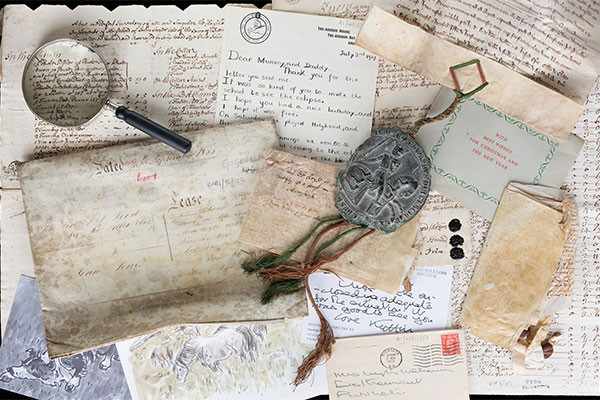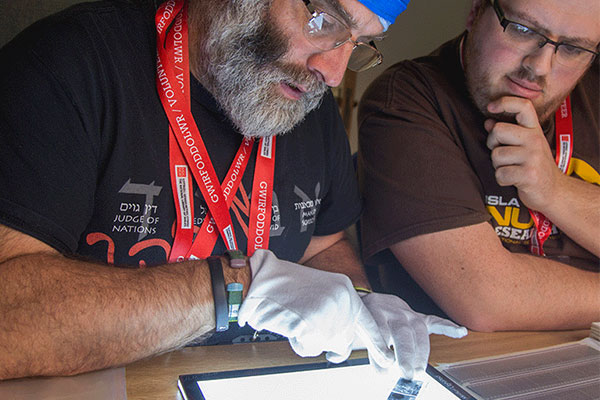The National Library of Wales has a large collection of charts, mostly modern Admiralty and commercial charts, but also antiquarian charts. Nautical charts (also known as marine or hydrographic charts) are maps primarily intended for navigation at sea.
They should provide sailors with clear, correct and up to date information e.g. coast lines, depths, and locations of submerged rocks, to help plan, plot and navigate a safe course on the water.
Designed to be working documents, charts would often have been amended and written on, and therefore would have been discarded when out of date or damaged. As a result, they are much less likely to have survived than ordinary maps.

Plans of harbours, bars, bays and roads in St. George's Channel, 1748 by Lewis Morris
Lewis and William Morris' Sea Charts
Lewis Morris (1701-1765) was a self-taught hydrographer from Anglesey. His work in land and marine surveying has received scant attention until recently. Morris's marine survey of the Welsh coast, undertaken with very little official support, was a supreme pioneering achievement.
Lewis Morris's son William Morris (1758-1808), revised and extended his father’s work, creating new plates. The general chart now displayed the entire Welsh coast whilst the volume included some additional harbour plans. The additions often show harbours which had increased in importance during the intervening years, such as Liverpool, Amlwch, Aberaeron, New Quay, Carmarthen, Burry and Swansea.
Plans of harbours, bars, bays and roads in St. George’s Channel, Lewis Morris Reference: Ab 1043
Plans of harbours, bars, bays and roads in St. George’s Channel, Lewis Morris
Reference: AB 1043
Plans of harbours, bars, bays and roads in St. George's Channel lately survey'd under the direction of the Lords of the Admiralty, and now publish'd by their permission, with an appendix concerning the improvements that might be made in the several harbours, &c. for the better securing the navigation in those parts together with a short account of the trade and manufactures on that coast, by Lewis Morris Monensis.
Plans of 24 Welsh harbours, including Conwy, Beaumaris, Red Wharf Bay, Dulas Bay, Cemlyn Bay, Holy Head Bay, Malltraeth Bay, Caernarfon Bay, Porth Dinllaen, Bardsey Sound, Aberdaron Road, St Tudwal's Road, Pwllheli, Barmouth Bay, Aberdyfi, Aberystwyth, Cardigan, Newport (Pembrokeshire), Fishguard, Ramsey Sound, Solfach, St. Bride's Bay, Milford Haven and Tenby. Includes soundings and information on currents, anchorages, drying banks, rocks and other navigation hazards and aids.
Plans of the principal harbours, bays, and roads in St. George’s and the Bristol Channels, William Morris Reference: Ab 1037
Plans of the principal harbours, bays, and roads in St. George’s and the Bristol Channels, William Morris
Reference: AB 1037
Plans of the principal harbours, bays, & roads in St. George's and the Bristol Channels from surveys made under the direction of the Lords of the Admiralty, by the late intelligent and ingenious hydrographer Lewis Morris Esq ... with additional observations from surveys lately made by William Morris.
Plans of 32 (mainly Welsh) harbours, including Liverpool, Chester, Red Wharf Bay, Dulas Bay, Amlwch, Cemlyn Bay, Conwy, Beaumaris, Holy Head Bay, Malltraeth Bay, Caernarfon Bay, Porth Dinllaen, Bardsey Sound, Aberdaron Road, St Tudwal's Road, Pwllheli, Barmouth Bay, Aberdyfi, Aberystwyth, Aberaeron, New Quay, Cardigan, Newport (Pembrokeshire), Fishguard, Ramsey Sound, Solfach, St. Bride's Bay, Milford Haven, Tenby, Carmarthen, Burry Port, Swansea and Dublin. Includes soundings and information on currents, anchorages, drying banks, rocks and other navigation hazards and aids.
Who was Lewis Morris?
Lewis Morris was of a celebrated Welsh family known as Morrisiad Môn [='The Morrises of Anglesey'], who are remembered for their cultural activities, which included involvement with the founding of the Honourable Society of Cymmrodorion. Lewis Morris had many and varied abilities and interests. He was an antiquary, literary scholar, philologist, mineralogist, customs officer, land surveyor and hydrographer.
His work in land and marine surveying has received scant attention until recently. Morris's marine survey of the Welsh coast, undertaken with very little official support, was a supreme pioneering achievement, especially for a self-taught hydrographer. It is for this marine survey that he is now recognized as one of the most eminent of British cartographers. Only in relatively recent times has it been brought to popular attention through the works of Dr A H W Robinson and Olwen Caradoc Evans, and the publication in 1987 of a facsimile edition of Plans of harbours ... (1748), which includes some of his hydgrographic work.
Lewis Morris was raised on a farm near Bae Dulas in Anglesey. Although he had little formal education, he was always eager to educate himself. Living near the sea, he would have observed vessels engaged in coastal trade or on passage to and from Liverpool and witnessed or heard about shipwrecks around the dangerous northern coast.
Morris's mathematical abilities secured his appointment as an estate surveyor to Owen Meyrick of Bodorgan, Anglesey in 1724 and for five years he mapped Meyrick's lands on the island. His field book, which includes sketches of farms and hovels on the Bodorgan estate is now at Bangor University Library. The completed work in two folio volumes is at Bodorgan. Much of Meyrick's estate was in coastal locations and it is probable that ideas for a coastal survey occurred to Morris at this time.
In 1729 he became a customs official at Holyhead and Beaumaris and listened to seamen bemoaning the inadequacy of contemporary local charts. At this time considerable use was made of the charts of Greenvile Collins, published in his Great Britain's Coasting Pilot in 1693, which were known to contain numerous inaccuracies.
Lewis Morris surveys the Welsh coast
In the interests of safer navigation Morris, under the patronage of the Admirality, decided to embark on the enormous task of surveying the Welsh coast, despite never having been formally trained as a marine surveyor. Welsh chart making had been neglected and shipping casualties were frequent. Because of the poor condition of Welsh roads, sea transport was more common at this time.
In 1734 Morris placed his survey proposals before the Lords Commissioners of the Admiralty in London, but it is apparent from his correspondence that they were not greatly enthused. Both the Admiralty and the Customs Commissioners refused to provide him with a vessel for surveying and Morris was obliged to hire one locally, at his own expense.
Morris embarked on his venture at Beaumaris in July 1737. In only one month he had mapped most of the coast of Anglesey, before beginning his marine survey. The charts he dispatched to the Admiralty later that year consisted of a folio volume of eleven manuscript maps entitled Cambria's Coasting Pilot, which were accompanied by sailing directions. However his hopes for their support were again dashed and in 1738 he continued his unaided survey. In 1739 Morris was dealt a further blow when the Custom Commissioners refused him further leave to pursue the survey.
Had it not been for the intervention of Owen Meyrick, his former employer, the survey would probably have been abandoned. Meyrick's influence extended to the Admiralty Office who in turn persuaded the Lords Commissioners to support the resumption of the survey in 1742. Morris was at Tenby in 1744, but the Admiralty, now preoccupied by the war with France, withdrew their support and further surveying was permanently halted.
The publication of Lewis Morris' Welsh coast chart
In 1748, with an upturn in the economy, the Admiralty encouraged the publication of his Welsh coast chart and individual harbour plans. They were published privately that September. The large chart showed the coast from Llandudno to Milford Haven. The harbour plans which had not originally been intended for publication, were prepared for Morris's own benefit and safety to show harbours and coves which offered him shelter in stormy weather. The small volume of twenty-five plans were a great success and sold to 1230 subscribers and others. All of his charts were a significant improvement on earlier ones and provided a wealth of additional large-scale local information on tidal streams, anchorages and hazards. These works preceded improved charts based on the Admiralty's own surveys by about seventy years.

‘Holy Head Bay’ from 'Plans of the principal harbours, bays, & roads in St. George's and the Bristol Channels', 1801 by William and Lewis Morris
Extending the Welsh coast chart
Morris's son William revised and extended the large chart in 1800 and the volume in 1801. The plates were new, but their contents derive essentially from his father's work. The general chart now displayed the entire Welsh coast whilst the volume included some additional harbour plans. The additions often show harbours which had increased in importance during the intervening years, such as Liverpool, Amlwch, Aberaeron, New Quay, Carmarthen, Burry and Swansea.




